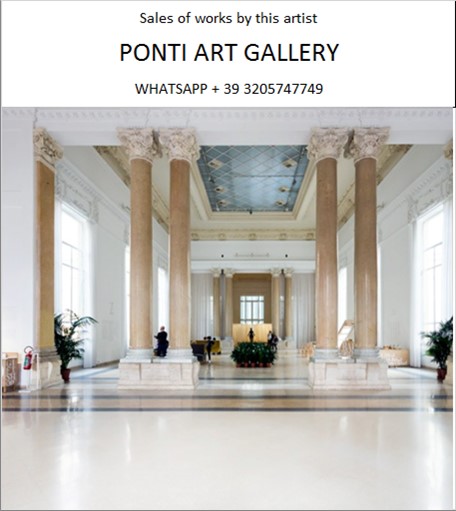Ponti Art Gallery is interested in buying and selling works
of art by this artist.

Maestro Christo Biography
Christo Vladimirov Javacheff, known simply as Christo, was born on June 13, 1935, in Gabrovo, Bulgaria, into a family well-connected with artists and intellectuals. His mother, Tzveta Dimitrova, was a political activist and had been a secretary at the National Academy of Art in Sofia, which undoubtedly influenced Christo's early exposure to art and culture. From a young age, Christo was inspired to make art, a passion that was encouraged by his parents and their social circle. He began his formal education in art at the National Academy of Art in Sofia in 1952, where he assisted in creating propaganda posters in the style of Socialist Realism, the government-sanctioned method of art production at the time.
The political climate of the era, marked by the Hungarian Revolution of 1956, prompted Christo to flee his homeland. He escaped to Prague hidden in a train wagon carrying medical supplies. From Prague, he moved to Vienna, where he studied sculpture at the Academy of Fine Arts. His journey did not end there; seeking greater freedom and opportunities, Christo traveled to Geneva and then to Paris, where he arrived in 1958. It was in Paris that Christo's life and career would take a pivotal turn. He supported himself by painting portraits on the streets, signing them with his family name, Javacheff.
In Paris, Christo met Jeanne-Claude Denat de Guillebon, a pivotal figure not only in his life but also in his artistic journey. Born on the same day as Christo, June 13, 1935, in Casablanca, Morocco, Jeanne-Claude was the daughter of an army officer. She brought her own unique perspective and skills to their partnership. The couple quickly discovered their shared passion for art and began their lifelong collaboration. They married and had a son, Cyril, in 1960, and moved to New York City four years later, where they would become recognized for their distinctive and ambitious art projects.
Christo and Jeanne-Claude are best known for their large-scale environmental installations that often involved wrapping buildings and landscapes in fabric. Their work transcended traditional notions of sculpture and painting, engaging directly with the environment and the public. One of their first notable projects was the "Wall of Oil Barrels – The Iron Curtain" in 1962, which consisted of oil barrels stacked to block a street in Paris. This project set the tone for their future work, which would continue to challenge and redefine the boundaries of art.
Their installations were monumental and temporary, altering familiar landscapes and urban environments in ways that provoked public dialogue and reevaluation of spaces. Projects such as "Wrapped Coast, One Million Square Feet" in Sydney, Australia (1969), "The Umbrellas, Japan-USA" (1991), and "Wrapped Reichstag" in Berlin, Germany (1995), showcased their innovative approach to art-making and their ability to execute complex projects on a grand scale. Each project required extensive planning, negotiation, and collaboration with various stakeholders, including government officials, environmentalists, and the public.
Christo's early works were influenced by the Nouveau Réalisme movement, which utilized everyday objects and materials in art. His experimentation with wrapping objects, from bicycles to beer cans and road signs, drew from artists like Jean Tinguely and Yves Klein. However, Christo and Jeanne-Claude's work transcended any single art movement, combining elements of sculpture, land art, and performance.
After Jeanne-Claude's death in 2009, Christo continued to pursue their shared vision, completing projects such as "The Floating Piers" on Italy's Lake Iseo in 2016 and posthumously, "L'Arc de Triomphe, Wrapped" in Paris in 2021. Christo passed away on May 31, 2020, in New York City, but his and Jeanne-Claude's legacy endures through their monumental works, which challenged perceptions of art and space and engaged millions of viewers around the world.
Their art was not just about the visual spectacle but also about the process—the bureaucratic negotiations, the engineering challenges, and the communal effort to bring these temporary artworks to life. Christo and Jeanne-Claude's projects were a testament to their belief in the freedom of art and its power to transform and engage the public imagination. Through their works, they invited viewers to see familiar landscapes anew, to reconsider the relationship between art, environment, and community, and to reflect on the ephemeral nature of beauty and human endeavor.
Maestro Christo Quotes and
Sales of Works
Ponti Art Gallery selects and deals with paintings by the
artist. Upon request, we provide free estimates and
evaluations, communicate prices, quotations, and current
market values.
If you are interested in BUYING or SELLING works by the
artist, contact us immediately.
If you wish to sell or receive an evaluation of the
works:
Send us a frontal photo of the painting, one of the back,
and one of the signature. Also, indicate the dimensions of
the work. Inform us about the purchase origin of the work
and any kind of available documentation (purchase
receipts, certificates of authenticity, publications). One
of our operators will respond to you on the same day. We
guarantee maximum confidentiality and extreme
professionalism.
If you wish to purchase works by the painter: Contact us
and let us know your request. We will inform you about the
available works. We also offer the possibility to
subscribe to our NEWSLETTER, through which you will be
informed at the beginning of each month about the latest
acquisitions of the art gallery.
You can send us pictures of the work:
